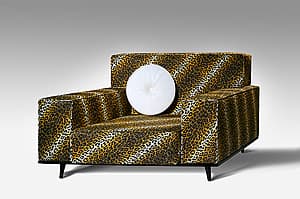

Claes Oldenburg
Learn moreLeopard chair 1963
© Claes Oldenburg and Coosje Van Bruggen Purchased 1978
More detail | PermalinkClaes Oldenburg was born in Stockholm, Sweden, but grew up in Chicago. He moved to New York in 1956 and became friendly with Allan Kaprow, Jim Dine, Red Grooms, Arthur Segel and others. In 1959–60 Oldenburg was sculpting with papier-maché and in 1961 he began making plaster replicas of items of food and cheap clothing, which he exhibited as The Store at the Martha Jackson Gallery, New York. He established the Ray Gun Theater at his studio in 1962, which became an important venue for performance art. Soft props created for performances led to his large-scale soft sculptures of stuffed canvas exhibited at the Green Gallery in 1962.
At the end of the summer of 1963, Oldenburg left New York for California to prepare an exhibition at the Dwan Gallery in Los Angeles in October that year. He rented a former bank building on the main street of the beachside suburb of Venice, and worked there until April 1964. Leopard chair 1963 was one of the first works he completed in his Venice studio and was included in this exhibition. Oldenburg wrote in 1966:
LA is many things and many things to many people. To me it is the paradise of industrialism. LA has the atmosphere (my selected part of it) of the consumer, of the home, the elegant neat result, like the frankfurter in its nonremembered distance from the slaughterhouse.[1]
Vinyl, and in particular the vinyl imitation of animal skins first used in Leopard chair, became Oldenburg’s preferred medium in Los Angeles. Leopard chair is also the first work for which Oldenburg enlisted the assistance of commercial manufacturers to produce a clean ‘machine style’ finish.[2] It initiated a series of furniture pieces that the artist collectively called The Home.
Leopard chair is the prototype of the furniture that appears in Oldenburg's most ambitious project on this theme, the recreation of an entire motel bedroom on which the artist worked in Venice in November and December 1963. It was installed as Bedroom ensemble at the Sidney Janis Gallery in January 1964, in the exhibition Four Environments by Four New Realists (the other three installations were by Dine, James Rosenquist and Segal).
Leopard chair also anticipates the furniture in Oldenburg’s Bedroom ensemble in its angular construction. The chair is rhomboidal in shape, translating into physical fact the shape the chair would assume if rendered illusionistically on a two‑dimensional surface according to the laws of perspective. Oldenburg has called it ‘upholstering perspective’. This teasing of the convention was prompted by newspaper advertisements the artist saw in the Los Angeles Times and clipped into his notebooks, showing furniture in exaggerated foreshortening to accentuate its streamlined appearance.[3] Leopard chair consists of four separate parts and a cushion that slot together to form the chair. It can, however, be rearranged―if less neatly―in different ways to recall the billboards of Los Angeles that face in all directions.[4]
Michael Lloyd and Michael Desmond[5]
[1] Oldenburg, quoted in Barbara Rose, Claes Oldenburg, Museum of Modern Art, New York, 1970, p 193.
[2] The manufacturer’s label is still glued to the bottom of the chair: ‘Associated UPH & MFG. Co, 312 VENICE WAY, VENICE CALIF’, guaranteeing the construction of the chair from ‘ALL NEW MATERIAL / CONSISTING OF / BODY: romeo fome’.
[3] Oldenburg, correspondence of 19 May 1986 with the National Gallery of Australia, NGA file 82/0670, enclosing photocopies of notebook pages of the period, filled with such newspaper clippings of furniture advertisements.
[4] See photograph of the Leopard chair rearranged in Coosje van Bruggen, Claes Oldenburg: Mouse Museum/Ray Gun Wing, Museum Ludwig, Cologne, 1979, p 52, fig b.
[5] Adapted and updated from Michael Lloyd and Michael Desmond, European and American paintings and sculptures 1870–1970 in the Australian National Gallery, Australian National Gallery, Canberra, 1992, p 325.

